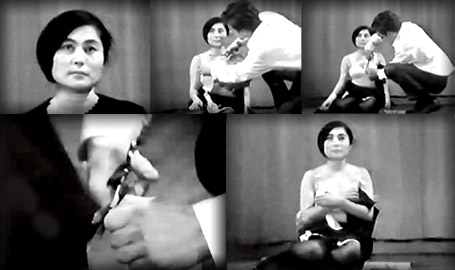Yoko Ono first performed ‘Cut Piece’ in 1964 in Japan. She repeated the performance at Carnegie Hall in New York in 1965. In September of 2003 she performed the piece for the last time in Paris.
The piece consists of a solitary perfomer, Yoko Ono, sitting on stage with a pair of scissors at her side – inviting the audience to come and cut off pieces of her clothing and take them away. (Audience members are given this instruction in a leaflet at the commencement of the piece.) Unflinching, she allows strangers to gradually remove portions of her clothing until there is nothing more to cut away at. The piece ends when nothing more can be cut, or when the performer decides that the piece has ended.
In her script for the piece Yoko Ono adds that the performer does not have to be a woman.
In all its manifestations, the piece is very powerful. Art historians and critics have descriped it- “more like a rape than an art performance”. Yoko Ono lies still and quiet, her eyes fixed and distant as pieces of fabric are removed from her body… first someone takes a sliver at the neck, then someone tears at an arm, then a piece is cut at her belly…and so the piece proceeds, sometimes with long pauses until somebody grows bold and proceeds again.
The piece is interactive and is created by what the audience brings to it. There is of course an element of trust – but it is the unpredictabilty of the piece that gives it power. It is a slow violation.
About the piece Yoko Ono says: “In the 1960s I did it out of anger.” As if taking all the violence of the world upon her. But of her last perfomrance in 2003, Yoko Ono says :”Following the political changes through the year after 9/11, I felt terribly vulnerable — like the most delicate wind could bring me tears, (…) Cut Piece is my hope for world peace.”
The two performances mirror themselves as both occur in turbulent political times and times of war. I see the peice as being about sacrifice, about the giving up of oneself – it is grown both out of love and anger, out of frustration and helplessness and out of inner strength and perseverance. Many things can happen to a person on the surface – changes can change the exterior, the material, but it is the integrity of self that gives us strentgh and grounding and is our shield.
The simplicity of the piece, without any explanation or judement, allows each viewer or participant to take from it what they will – one can observe what is taking place and yet no interpretation is imposed on the event. Following the performance, a spectator remarked the following about Yoko Ono: “Her inventive sometimes provocative game-like concepts and instructions encourage us to step over the bouderies of art’s constraints to construct art inside ourselves.”
Moving art performances can create a change within the self – and it is from that open place of change and creation within the self that we can grow and share and trust one another.

